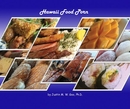Generally, the Japanese aren't originators. Their strength is to take things that other people have come up with and refine it to the point of perfection. Just look at the automotive world and the electronics world. So it should be no surprise that this applies to the food world as well. And perhaps one of the most iconic Japanese foods is their noodles. There are so many styles of noodles around the world. While (thanks to Marco Polo) the Italians have spaghetti, linguine, fettuccine, and vermicelli, the Japanese have ramen, somen, udon, and soba. Of these, the one that I usually like least is udon.
Udon is the thicker, rounder, chewier Japanese noodle. Because of it's thickness and consistency, it generally does not cluster together the way that fine noodles do. It's much easier to isolate an individual noodle than with thinner noodles. The byproduct of this, is that it does not trap as much of the surrounding sauce or liquid than thinner noodles do. Therefore, the texture of the noodle must stand out on its own much more. The reason that I usually don't like udon noodles, is that they're generally too tough or chewy. The thickness alone makes them firmer, since you've got more noodle to bite through. This is especially so of dried udon noodles that need to be reconstituted.
I didn't really start to appreciate the udon until I was travelling to Guam on business one year. It was an extruciatingly long flight, almost 18 hours total. The only stopover I had was in Narita Airport, just outside of Tokyo. Tired, cramped, and jet lagged, I hobbled around the airport looking for something to eat, and what did I find, but a udon noodle shop. Figuring I was in the country of it's inception, I thought I might as well give a bowl a chance. Because I was tired and hungry, the warmth of the soup really perked me up. And the noodles, were a much better texture than I was expecting. Because they were thicker, they were also a little more substantial to a weary traveler. Having found udon that I actually liked, I decided to try to hunt for it at home. After much searching, I finally found what may be the perfect noodle, at Jimbo Restaurant, on S. King just before McCully (next to where King's Bakery and later Machino Chaya used to be).
Hot Udon and Okayko Donburi Combo at Jimbo Restaurant
Jimbo is a perfect example of the Japanese perfectionism. They focus on basically one thing, their udon noodle. It is entirely handmade by themselves, and because the noodles are fresh and never reconstituted, the texture is absolutely perfect. The udon is softer than any other I've had, but still has enough chewiness to satisfy your appetite. But to me the best thing is their slight variation, "hoso udon" or skinny udon. Here are the same classic udon noodles, but just slightly skinnier, so it alleviates some of the trappings of the thick noodle.
Zaru Udon and Tempura Combo at Jimbo Restaurant
Udon is classically served hot. The pairing of the udon in broth with another dish like an okayo donburi makes for a fantastic meal. But Jimbo also balances it out by serving them cold (zaru udon) as well. Usually, the cold serving is done with soba noodles, not udon, but somehow the with Jimbo's hoso udon it works really well. The hoso udon is more slippery than soba traditionally is, so it has a wonderful mouth feel slurping them up.
Zaru Udon close up at Jimbo Restaurant
When looking for the perfect noodle, Jimbo's udon just may top that list in the islands. That really says something, considering I generally like udon noodles the least. That just goes to show what an obsession with perfectionism can do.






No comments:
Post a Comment